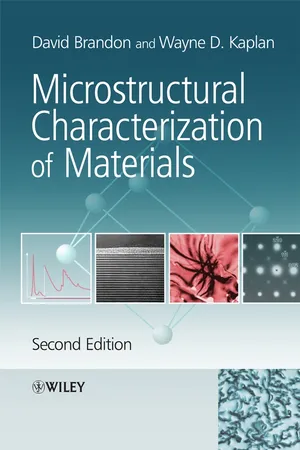
- English
- ePUB (mobile friendly)
- Available on iOS & Android
Microstructural Characterization of Materials
About This Book
Microstructural characterization is usually achieved by allowing some form of probe to interact with a carefully prepared specimen. The most commonly used probes are visible light, X-ray radiation, a high-energy electron beam, or a sharp, flexible needle. These four types of probe form the basis for optical microscopy, X-ray diffraction, electron microscopy, and scanning probe microscopy. Microstructural Characterization of Materials, 2nd Edition is an introduction to the expertise involved in assessing the microstructure of engineering materials and to the experimental methods used for this purpose. Similar to the first edition, this 2nd edition explores the methodology of materials characterization under the three headings of crystal structure, microstructural morphology, and microanalysis. The principal methods of characterization, including diffraction analysis, optical microscopy, electron microscopy, and chemical microanalytical techniques are treated both qualitatively and quantitatively. An additional chapter has been added to the new edition to cover surface probe microscopy, and there are new sections on digital image recording and analysis, orientation imaging microscopy, focused ion-beam instruments, atom-probe microscopy, and 3-D image reconstruction. As well as being fully updated, this second edition also includes revised and expanded examples and exercises, with a solutions manual available at http://develop.wiley.co.uk/microstructural2e/ Microstructural Characterization of Materials, 2nd Edition will appeal to senior undergraduate and graduate students of material science, materials engineering, and materials chemistry, as well as to qualified engineers and more advanced researchers, whowill find the book a useful and comprehensive general reference source.
Frequently asked questions
Information
Table of contents
- Cover
- Contents
- Title page
- Copyright
- Preface to the Second Edition
- Preface to the First Edition
- 1 The Concept of Microstructure
- 2 Diffraction Analysis of Crystal Structure
- 3 Optical Microscopy
- 4 Transmission Electron Microscopy
- 5 Scanning Electron Microscopy
- 6 Microanalysis in Electron Microscopy
- 7 Scanning Probe Microscopy and Related Techniques
- 8 Chemical Analysis of Surface Composition
- 9 Quantitative and Tomographic Analysis of Microstructure
- Appendices
- Index